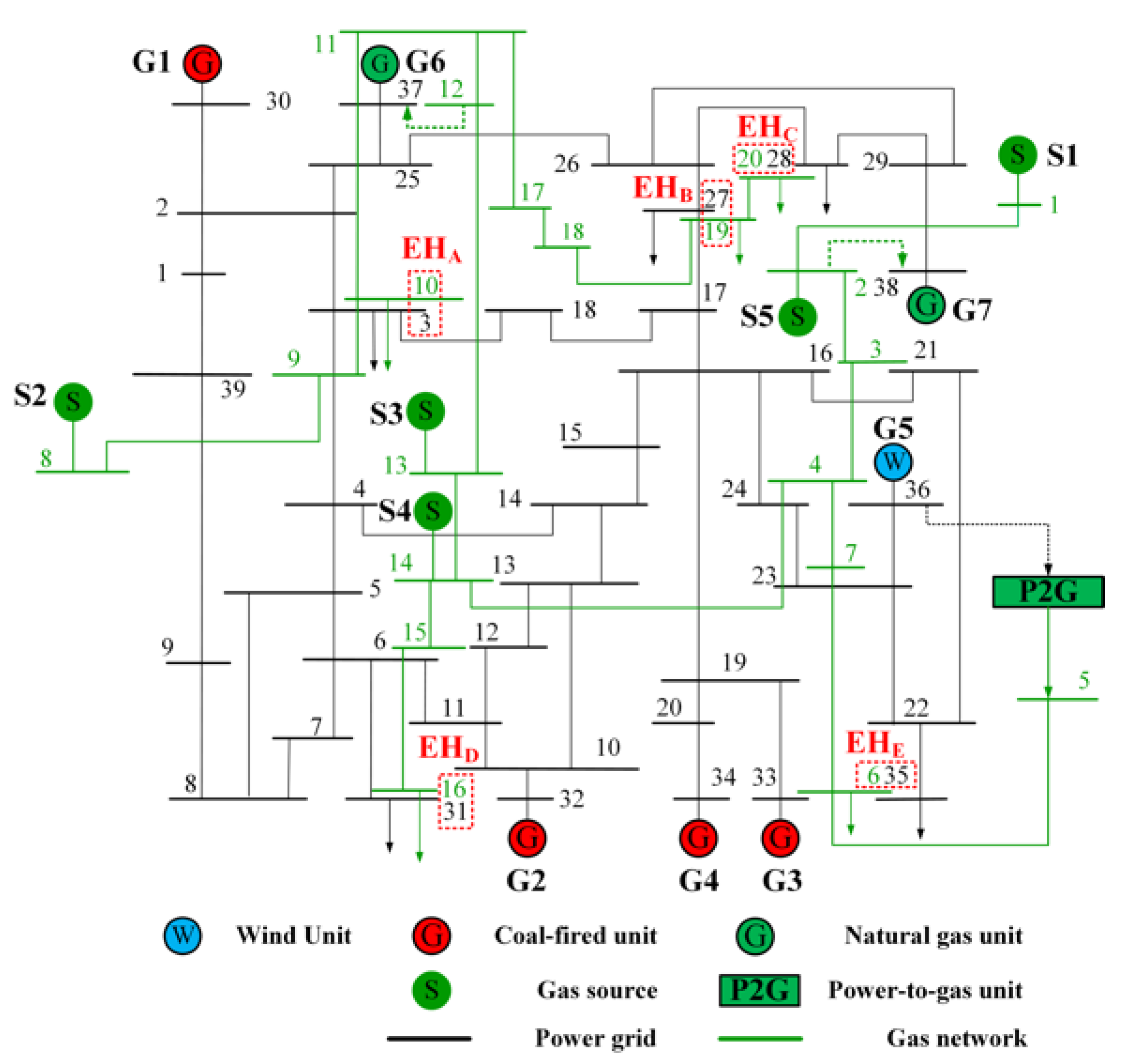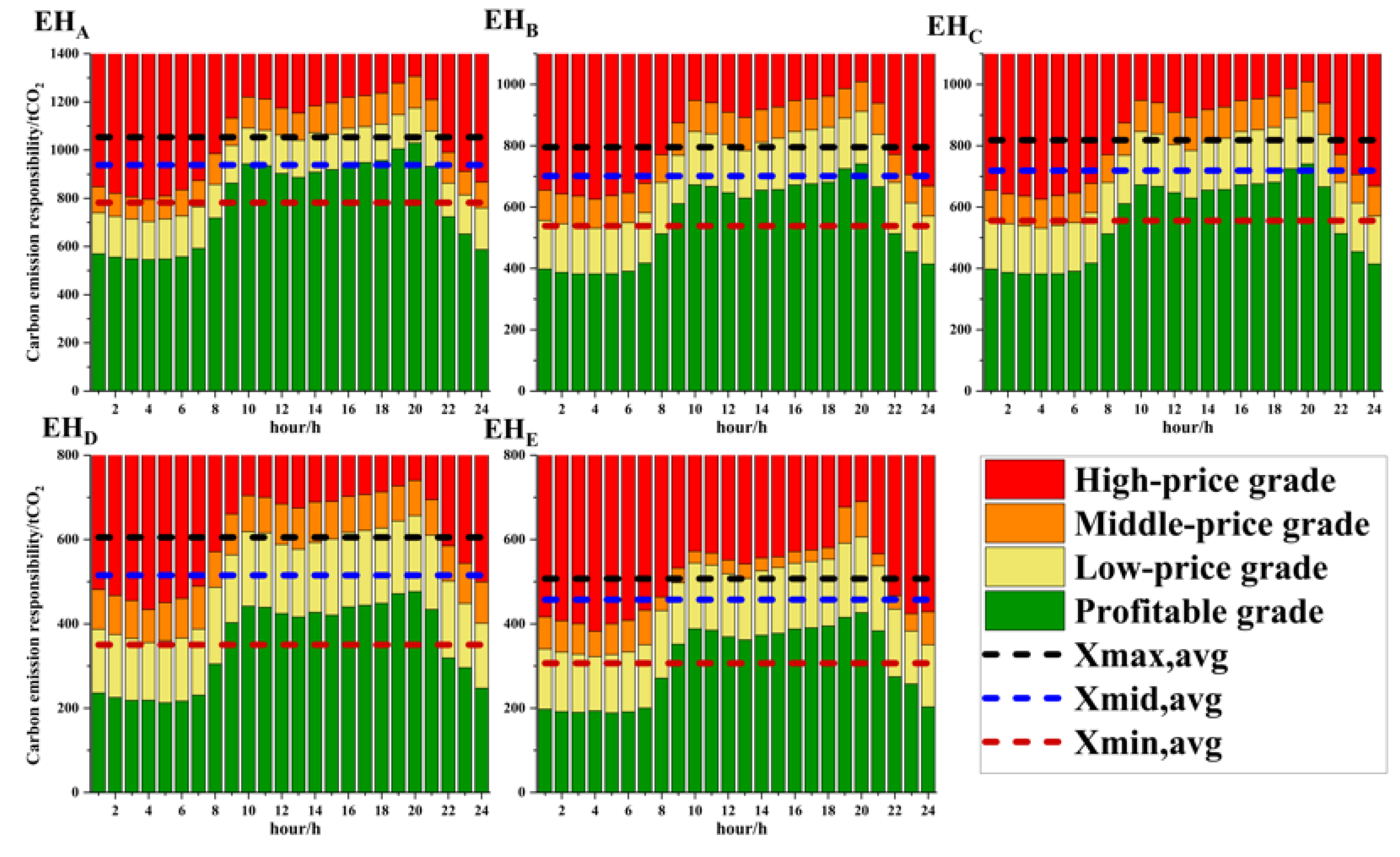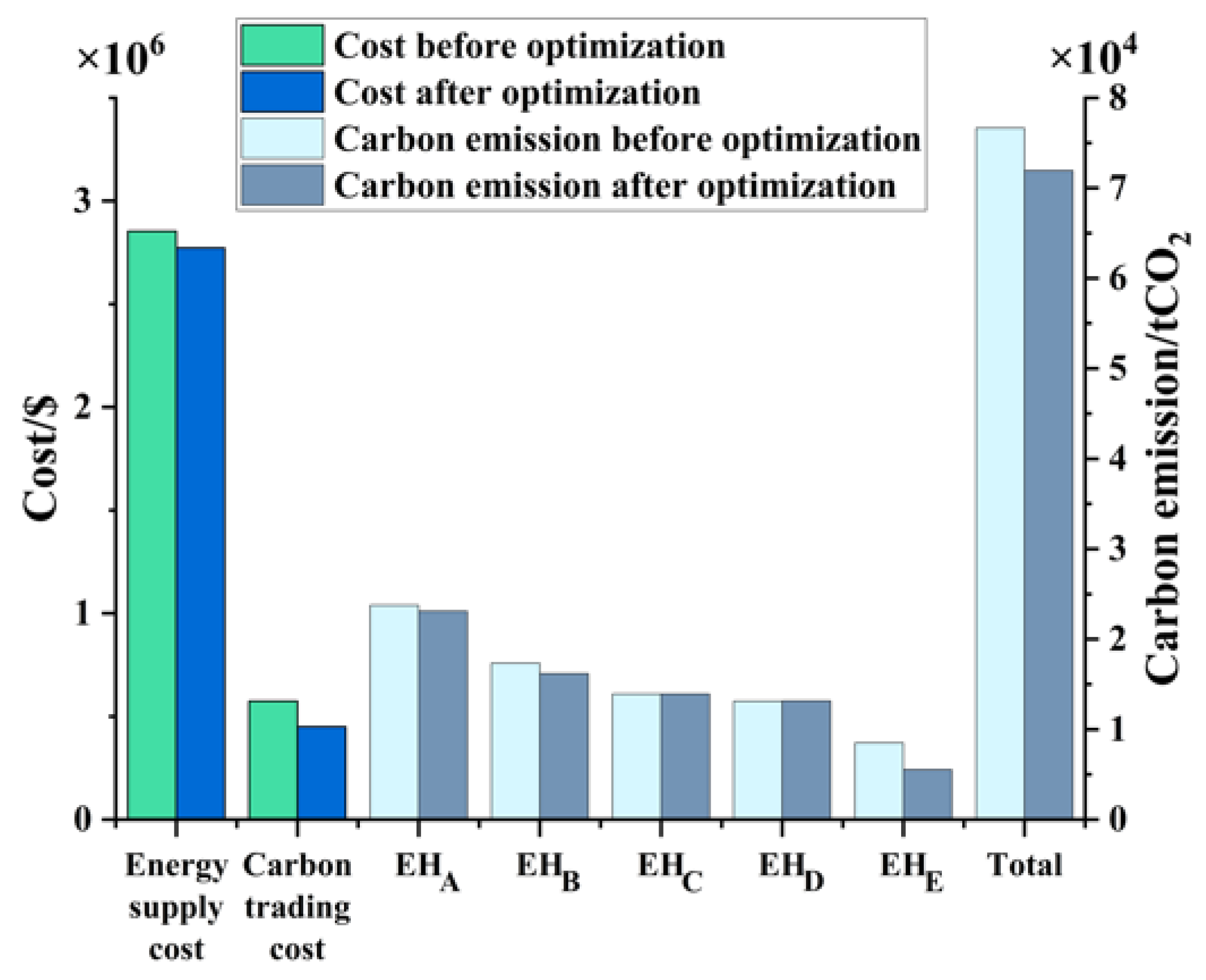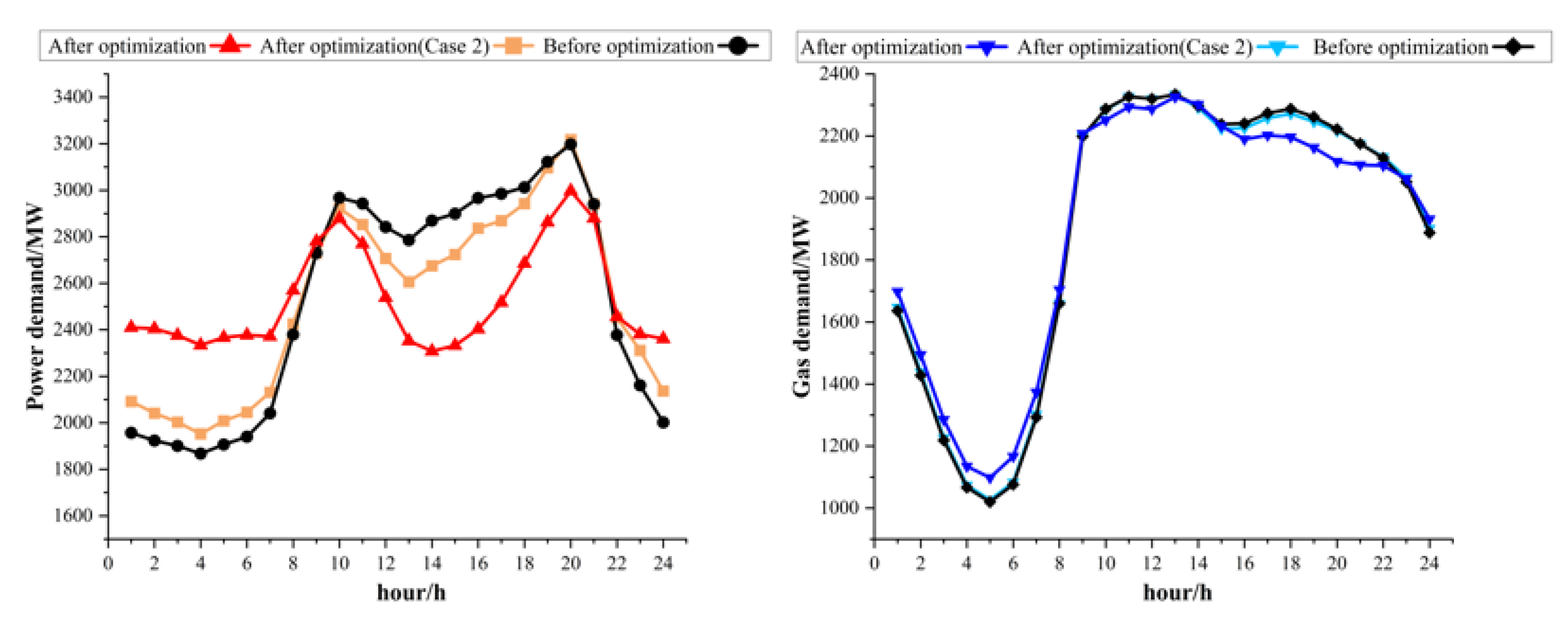Source-Load Coordinated Low-Carbon Economic Dispatch of Electric-Gas Integrated Energy System Based on Carbon Emission Flow Theory
Abstract
:1. Introduction
- This paper proposes a two-stage low-carbon economic dispatch model of the IES based on the CEF theory. On the basis of considering the load-side carbon responsibility and demand response, the source and load are coordinately optimized to realize the low-carbon economic operation of the IES;
- Based on the Shapley value method, a method for the division of the carbon emission responsibility grades of each energy hub is proposed, and a ladder-type carbon trading mechanism is formulated;
- Through the analysis of three scenarios, the effectiveness of the model proposed in this paper is verified in the IESs with different renewable energy penetration rates, and the mechanism of the demand response is elaborated. Furthermore, the proposed method is proven to have superiority over the other two related existing methods in carbon reduction.
2. Load-Side Carbon Responsibility Allocation Method Based on Carbon Emission Flow Theory and Shapley Value Method
2.1. CEF in Power System Considering Grid Losses
2.2. CEF in a Natural Gas System
2.3. Allocation of Carbon Emission Responsibility Based on the Shapley Value Method
3. A Two-Stage Low-Carbon Economic Dispatch Model Considering Demand Response
3.1. The Two-Stage Model Overview
- Preparatory work: Based on the method proposed in Section 2, the carbon emission responsibility grades of each EH are calculated using the input data. Thus, a ladder-type carbon trading mechanism is formed to calculate the load-side carbon trading cost in the second stage;
- The first stage: An economic dispatch optimization is performed with the objective function of minimizing the energy supply cost. The flow data of the IES are obtained by optimization. These are then passed to the CEF model to calculate the carbon intensity of each load node;
- The second stage: Based on the first stage, this stage is optimized with the objective function of minimizing the carbon trading cost of the load side. The optimal demand response values are obtained after the optimization;
- Loop solution and output: The response values optimized by the second stage cause load changes, and therefore, it is necessary to use the new load values to perform the first-stage economic dispatch calculation. Finally, a two-stage loop calculation is performed until the objective function values of the two stages tend to be stable.
- Without considering the impact of the reactive power flow on the system carbon emissions, the DC power flow modeling was adopted for the power system;
- Without considering the pipeline inventory, the steady-state pipeline modeling was adopted for the gas network;
- The demand-side response was based on the premise that the total energy demand for a day remained unchanged;
- Without considering the power or gas load types, the load response ranges are set to constrain the load response capability.
3.2. The First Stage: Economic Dispatch Model
3.2.1. Objective Function
3.2.2. Constraints
- (1)
- Power system model
- (a)
- Unit constraints:where and represent the upper and lower output limits of the coal-fired units; and represent the upper and lower output limits of the gas-fired units, respectively; and represent the upper and lower output limits of the wind turbines; , , and are the actual outputs of the coal-fired units, gas-fired units, and wind turbines at time , respectively; is the power generation efficiency of the gas-fired units; is the mass flow rate of natural gas consumed by the gas-fired unit, respectively; and represent the upper and lower output limits of the coal-fired units; and represent the upper and lower output limits of the gas-fired units, respectively.
- (b)
- Branch constraints:where and represent the power flow and branch losses of branch at time , respectively; is the phase angle difference between the two ends of branch at time ; and are the reactance and conductance of branch ; and are the upper and lower power transmission limits of branch .
- (c)
- Bus constraintswhere , and represent the power injected into bus from the coal-fired units, gas-fired units, and wind turbines, respectively; represents the load on bus ; represents the set of all buses around bus ; represents the power consumed by the P2G equipment on bus ; is the energy conversion efficiency of P2G; represents the gas mass flow rate supplied by P2G to node ; and represent the upper and lower phase difference limits of branch ; is the phase angle of the slack bus at time .
- (2)
- Natural gas system model
- (a)
- Natural gas source constraints:where represents the mass flow rate of the gas source at node ; and represent the upper and lower mass flow rate limits of the gas source at node .
- (b)
- Pipeline constraints:where represents the gas mass flow rate of pipeline at time . is a constant that depends on the length, diameter, and absolute rugosity of the pipe and the gas composition [32]; and denote the gas pressure at nodes and , respectively; and are the upper and lower mass flow rate limits of pipeline .
- (c)
- Node constraints:where represents the gas load at node ; and represent the upper and lower gas pressure limits of node .
3.3. The Second Stage: Demand Response Model
3.3.1. Objective Function
3.3.2. Constraints
- (1)
- Carbon trading cost constraints:
- (2)
- Carbon emission constraints:
- (3)
- Demand response constraints:
4. Case Study and Discussion
4.1. A. Modified IEEE 39-Bus Power System/Belgian 20-Node Natural Gas System
4.1.1. Basic Data of the System
4.1.2. Formation of the Ladder-Type Carbon Trading Mechanism for the Five EHs
4.2. Analysis of Scenarios with and without Wind Power
4.2.1. Scenario 1: Without Wind Power
4.2.2. Scenario 2: With Wind Power
4.2.3. Scenario 3: With Different Wind Penetration Rates
4.3. Discussion of the DR Mechanism
4.3.1. Influence Mechanism of the Ladder-Type Carbon Prices on the DR
- Case 1: Constant carbon pricing;
- Case 2: Ladder-type carbon pricing.
4.3.2. Influence Mechanism of Carbon Emissions on the DR
4.4. Discussion of Three Carbon Reduction Methods
5. Conclusions
- The two-stage model proposed in this paper could effectively reduce the peak-to-valley difference, enhance the ability of the system to consume wind power, and reduce the system carbon emissions by 6.2% and the carbon trading cost by 21.7%.
- As the wind power penetration rate of the system increased from 20% to 80%, the carbon reduction effect of the model remained basically stable, with a slight increase from 6.2% to 6.8%. Therefore, with the growth in renewable energy, the two-stage model considering the demand response proposed in this paper can still effectively reduce carbon emissions.
- Based on the Shapley value method, the user-side ladder-type carbon trading mechanism was thus formulated. The method proposed in this paper drives the demand response through user-side carbon trading. By comparing the proposed method with the other two related existing methods, the carbon emission reduction effect of the proposed method was 281.8% and 203.7% of the other two methods, respectively. Therefore, the proposed method was proven to have superiority over the other two methods in carbon reduction.
Author Contributions
Funding
Institutional Review Board Statement
Informed Consent Statement
Data Availability Statement
Conflicts of Interest
References
- Moore, F.C.; Lacasse, K.; Mach, K.J.; Shin, Y.A.; Gross, L.J.; Beckage, B. Determinants of emissions pathways in the coupled climate–social system. Nature 2022, 603, 103–111. [Google Scholar] [CrossRef] [PubMed]
- Sognnaes, I.; Gambhir, A.; van de Ven, D.-J.; Nikas, A.; Anger-Kraavi, A.; Bui, H.; Campagnolo, L.; Delpiazzo, E.; Doukas, H.; Giarola, S.; et al. A multi-model analysis of long-term emissions and warming implications of current mitigation efforts. Nat. Clim. Change 2021, 11, 1055–1062. [Google Scholar] [CrossRef]
- Huang, W.; Zhang, N.; Cheng, Y.; Yang, J.; Wang, Y.; Kang, C. Multienergy Networks Analytics: Standardized Modeling, Optimization, and Low Carbon Analysis. Proc. IEEE 2020, 108, 1411–1436. [Google Scholar] [CrossRef]
- Wang, Y.; Wang, Y.; Huang, Y.; Yu, H.; Du, R.; Zhang, F.; Zhang, F.; Zhu, J. Optimal Scheduling of the Regional Integrated Energy System Considering Economy and Environment. IEEE Trans. Sustain. Energy 2019, 10, 1939–1949. [Google Scholar] [CrossRef]
- Liu, N.; Wang, J.; Wang, L. Hybrid Energy Sharing for Multiple Microgrids in an Integrated Heat–Electricity Energy System. IEEE Trans. Sustain. Energy 2019, 10, 1139–1151. [Google Scholar] [CrossRef]
- Zhu, X.; Yang, J.; Liu, Y.; Liu, C.; Miao, B.; Chen, L. Optimal Scheduling Method for a Regional Integrated Energy System Considering Joint Virtual Energy Storage. IEEE Access 2019, 7, 138260–138272. [Google Scholar] [CrossRef]
- Zhang, Z.; Jing, R.; Lin, J.; Wang, X.; van Dam, K.H.; Wang, M.; Meng, C.; Xie, S.; Zhao, Y. Combining agent-based residential demand modeling with design optimization for integrated energy systems planning and operation. Appl. Energy 2020, 263, 114623. [Google Scholar] [CrossRef]
- Fu, Y.; Sun, Q.; Wennersten, R. The effect of correlation of uncertainties on collaborative optimization of integrated energy system. Energy Rep. 2021, 7, 586–592. [Google Scholar] [CrossRef]
- Wang, R.; Wen, X.; Wang, X.; Fu, Y.; Zhang, Y. Low carbon optimal operation of integrated energy system based on carbon capture technology, LCA carbon emissions and ladder-type carbon trading. Appl. Energy 2022, 311, 118664. [Google Scholar] [CrossRef]
- Chen, L.; Msigwa, G.; Yang, M.; Osman, A.I.; Fawzy, S.; Rooney, D.W.; Yap, P.S. Strategies to achieve a carbon neutral society: A review. Environ. Chem. Lett. 2022, 1–34. [Google Scholar] [CrossRef]
- Huang, Y.; Ding, T.; Li, Y.; Li, L.; Chi, F.; Wang, K.; Wang, X.; Wang, X. Decarbonization Technologies and Inspirations for the Development of Novel Power Systems in the Context of Carbon Neutrality. Proc. CSEE 2021, 41, 28–51. [Google Scholar] [CrossRef]
- Peñasco, C.; Anadón, L.D.; Verdolini, E. Systematic review of the outcomes and trade-offs of ten types of decarbonization policy instruments. Nat. Clim. Change 2021, 11, 257–265. [Google Scholar] [CrossRef]
- Miao, B.; Lin, J.; Li, H.; Liu, C.; Li, B.; Zhu, X.; Yang, J. Day-Ahead Energy Trading Strategy of Regional Integrated Energy System Considering Energy Cascade Utilization. IEEE Access 2020, 8, 138021–138035. [Google Scholar] [CrossRef]
- Peng, Q.; Wang, X.; Kuang, Y.; Wang, Y.; Zhao, H.; Wang, Z.; Lyu, J. Hybrid energy sharing mechanism for integrated energy systems based on the Stackelberg game. CSEE J. Power Energy Syst. 2021, 7, 911–921. [Google Scholar] [CrossRef]
- Xu, D.; Zhou, B.; Wu, Q.; Chung, C.Y.; Li, C.; Huang, S.; Chen, S. Integrated Modelling and Enhanced Utilization of Power-to-Ammonia for High Renewable Penetrated Multi-Energy Systems. IEEE Trans. Power Syst. 2020, 35, 4769–4780. [Google Scholar] [CrossRef]
- Gu, N.; Wang, H.; Zhang, J.; Wu, C. Bridging Chance-Constrained and Robust Optimization in an Emission-Aware Economic Dispatch With Energy Storage. IEEE Trans. Power Syst. 2022, 37, 1078–1090. [Google Scholar] [CrossRef]
- Wang, Y.; Wang, Y.; Huang, Y.; Yang, J.; Ma, Y.; Yu, H.; Zeng, M.; Zhang, F.; Zhang, Y. Operation optimization of regional integrated energy system based on the modeling of electricity-thermal-natural gas network. Appl. Energy 2019, 251, 113410. [Google Scholar] [CrossRef]
- Misconel, S.; Zöphel, C.; Möst, D. Assessing the value of demand response in a decarbonized energy system—A large-scale model application. Appl. Energy 2021, 299, 117326. [Google Scholar] [CrossRef]
- Lv, G.; Cao, B.; Dexiang, J.; Wang, N.; Li, J.; Chen, G. Optimal scheduling of regional integrated energy system considering integrated demand response. CSEE J. Power Energy Syst. 2021, 1–10. [Google Scholar] [CrossRef]
- Yu, B.; Sun, F.; Chen, C.; Fu, G.; Hu, L. Power demand response in the context of smart home application. Energy 2022, 240, 122774. [Google Scholar] [CrossRef]
- Guo, B.; Weeks, M. Dynamic tariffs, demand response, and regulation in retail electricity markets. Energy Econ. 2022, 106, 105774. [Google Scholar] [CrossRef]
- Yuan, G.; Gao, Y.; Ye, B.; Liu, Z. A bilevel programming approach for real-time pricing strategy of smart grid considering multi-microgrids connection. Int. J. Energy Res. 2021, 45, 10572–10589. [Google Scholar] [CrossRef]
- Yuan, G.; Gao, Y.; Ye, B. Optimal dispatching strategy and real-time pricing for multi-regional integrated energy systems based on demand response. Renew. Energy 2021, 179, 1424–1446. [Google Scholar] [CrossRef]
- Zhou, T.; Kang, C.; Xu, Q.; Chen, Q. Preliminary Theoretical Investigation on Power System Carbon Emission Flow. Autom. Electr. Power Syst. 2012, 36, 38–43. [Google Scholar]
- Kang, C.; Zhou, T.; Chen, Q.; Wang, J.; Sun, Y.; Xia, Q.; Yan, H. Carbon Emission Flow From Generation to Demand: A Network-Based Model. IEEE Trans. Smart Grid 2015, 6, 2386–2394. [Google Scholar] [CrossRef]
- Cheng, Y.; Zhang, N.; Wang, Y.; Yang, J.; Kang, C.; Xia, Q. Modeling Carbon Emission Flow in Multiple Energy Systems. IEEE Trans. Smart Grid 2019, 10, 3562–3574. [Google Scholar] [CrossRef]
- Cheng, Y.; Zhang, N.; Zhang, B.; Kang, C.; Xi, W.; Feng, M. Low-Carbon Operation of Multiple Energy Systems Based on Energy-Carbon Integrated Prices. IEEE Trans. Smart Grid 2020, 11, 1307–1318. [Google Scholar] [CrossRef]
- Electric power transmission and distribution losses. OECD/IEA 2018.
- Bialek, J. Tracing the Flow of Electricity. IEE Proc. Gener. Transm. Distrib. 1996, 143, 313–320. [Google Scholar] [CrossRef] [Green Version]
- Zhou, Q.; Feng, D.; Xu, C.; Feng, C.; Sun, T.; Ding, T. Methods for Allocating Carbon Obligation in Demand Side:a Comparative Study. Autom. Electr. Power Syst. 2015, 7, 153–159. [Google Scholar]
- Yang, L.; Xu, Y.; Sun, H.; Zhao, X. Two-Stage Convexification-Based Optimal Electricity-Gas Flow. IEEE Trans. Smart Grid 2020, 11, 1465–1475. [Google Scholar] [CrossRef]
- De Wolf, D.; Smeers, Y. The Gas Transmission Problem Solved by an Extension of the Simplex Algorithm. Manag. Sci. 2000, 46, 1454–1465. [Google Scholar] [CrossRef] [Green Version]
- Zimmerman, R.D.; Murillo-Sánchez, C.E. MATPOWER User’s Manual; Power Systems Engineering Research Center: Washington, DC, USA, 2011. [Google Scholar]
- Wang, Y.; Zhou, S.; Wang, Y.; Qin, X.; Chen, F.; Ou, X. Comprehensive assessment of the environmental impact of China’s nuclear and other power generation technologies. J. Tsinghua Univ. (Sci. Technol.) 2021, 61, 377–384. [Google Scholar] [CrossRef]
- Cao, Y.; Wei, W.; Wu, L.; Mei, S.; Shahidehpour, M.; Li, Z. Decentralized Operation of Interdependent Power Distribution Network and District Heating Network: A Market-Driven Approach. IEEE Trans. Smart Grid 2019, 10, 5374–5385. [Google Scholar] [CrossRef]



















| Unit | Type | Capacity /(MW) | Cost Coefficient /($/MW) | Emission Intensity /(t CO2/MW) |
|---|---|---|---|---|
| G1 | Coal-fired | 1040 | 35 | 1.280 |
| G2 | Coal-fired | 725 | 35 | 1.300 |
| G3 | Coal-fired | 652 | 35 | 1.290 |
| G4 | Coal-fired | 508 | 35 | 1.270 |
| G6 | Gas-fired | 564 | \ | 0.564 |
| G7 | Gas-fired | 865 | \ | 0.550 |
| Capacity /(MBtu/h) | Cost Coefficient /($/MBtu) | Emission Intensity /(t CO2/MBtu) | Capacity /(MBtu/h) | Cost Coefficient /($/MBtu) |
|---|---|---|---|---|
| S1 | 15,000 | 11.6 | 0.0566 | 1.300 |
| S2 | 20,000 | 10.8 | 0.0566 | 1.290 |
| S3 | 1000 | 12.0 | 0.0566 | 1.270 |
| S4 | 250 | 10.2 | 0.0566 | 0.564 |
| S5 | 250 | 10.0 | 0.0566 | 0.550 |
| EH | Power Load/(MW) | Gas Load/(MBtu/h) |
|---|---|---|
| EHA | 913.6 | 526.2 |
| EHB | 685.2 | 25.0 |
| EHC | 685.2 | 158.6 |
| EHD | 456.8 | 1290.9 |
| EHE | 456.8 | 333.5 |
| Piecewise Interval | Carbon Price/($/t CO2) |
|---|---|
| Sub-Alliance | Carbon Emission Responsibility /(t CO2) | Sub-Alliance | Carbon Emission Responsibility /(t CO2) |
|---|---|---|---|
| {A} | 574.70 | \ | \ |
| {B} | 375.29 | {A, B} | 1075.64 |
| {C} | 382.63 | {A, C} | 1087.93 |
| {D} | 48.77 | {A, D} | 1124.59 |
| {E} | 10.40 | {A, E} | 1089.93 |
| {B, C} | 1067.71 | {A, B, C} | 1480.67 |
| {B, D} | 929.60 | {A, B, D} | 1505.31 |
| {B, E} | 883.47 | {A, B, E} | 1476.86 |
| {C, D} | 939.98 | {A, C, D} | 1526.90 |
| {C, E} | 897.98 | {A, C, E} | 1489.16 |
| {D, E} | 574.60 | {A, D, E} | 1139.50 |
| {B, C, D} | 1120.59 | {A, B, C, D} | 1550.08 |
| {B, C, E} | 1082.62 | {A, B, C, E} | 1508.31 |
| {B, D, E} | 1120.91 | {A, B, D, E} | 1520.23 |
| {C, D, E} | 1130.49 | {A, C, D, E} | 1541.82 |
| {B, C, D, E} | 1520.13 | {A, B, C, D, E} | 2458.65 |
Publisher’s Note: MDPI stays neutral with regard to jurisdictional claims in published maps and institutional affiliations. |
© 2022 by the authors. Licensee MDPI, Basel, Switzerland. This article is an open access article distributed under the terms and conditions of the Creative Commons Attribution (CC BY) license (https://creativecommons.org/licenses/by/4.0/).
Share and Cite
Feng, J.; Nan, J.; Wang, C.; Sun, K.; Deng, X.; Zhou, H. Source-Load Coordinated Low-Carbon Economic Dispatch of Electric-Gas Integrated Energy System Based on Carbon Emission Flow Theory. Energies 2022, 15, 3641. https://doi.org/10.3390/en15103641
Feng J, Nan J, Wang C, Sun K, Deng X, Zhou H. Source-Load Coordinated Low-Carbon Economic Dispatch of Electric-Gas Integrated Energy System Based on Carbon Emission Flow Theory. Energies. 2022; 15(10):3641. https://doi.org/10.3390/en15103641
Chicago/Turabian StyleFeng, Jieran, Junpei Nan, Chao Wang, Ke Sun, Xu Deng, and Hao Zhou. 2022. "Source-Load Coordinated Low-Carbon Economic Dispatch of Electric-Gas Integrated Energy System Based on Carbon Emission Flow Theory" Energies 15, no. 10: 3641. https://doi.org/10.3390/en15103641
APA StyleFeng, J., Nan, J., Wang, C., Sun, K., Deng, X., & Zhou, H. (2022). Source-Load Coordinated Low-Carbon Economic Dispatch of Electric-Gas Integrated Energy System Based on Carbon Emission Flow Theory. Energies, 15(10), 3641. https://doi.org/10.3390/en15103641









